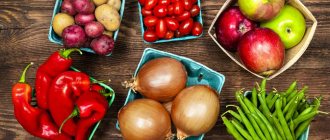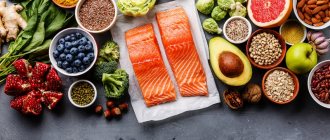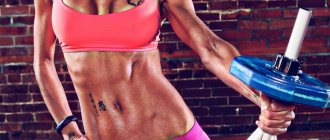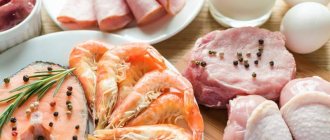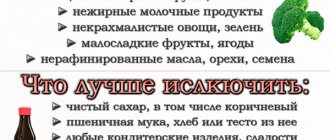Proteins are the basis for the construction of new cells in the body. But sometimes, for medical reasons, it is necessary to reduce protein intake. With a lack of building material, albumin synthesis slows down, and the body uses muscles to maintain basic functions. For a healthy person, you can consume protein-free foods for no more than one week, otherwise health problems will arise.
Principles of a protein-free diet
Protein restriction allows you to reduce weight or relieve excess stress on certain organs. Reducing protein intake is the principle of a protein-free diet. Products containing building materials for the body should be consumed in small quantities.
The diet is not intended for quick weight loss. During this period, it is not recommended to increase physical activity, since protein will be required to replenish muscle energy. A protein-free diet includes a large amount of carbohydrates, which also do not contribute to weight loss.
The daily amount of calories is about 2000. There is no point in using such a diet for weight loss for a healthy person. It is better to have protein-free days a couple of times a week.
Basically, protein restrictions are imposed by doctors for kidney or liver disease. The diet is therapeutic and allows the body to independently remove nitrogenous compounds, which play a negative role in diseases of internal organs.
Reviews and results
Tamara Vyacheslavovna Antipkina, 44 years old, Voskresensk
Elevated creatinine concentrations and hypertension forced me to see a doctor, who recommended adjusting my diet using a low-protein diet. He developed a nutrition plan for me individually. I have been following the diet for a month now. During this time, my laboratory values returned to normal slightly.
At the same time, I began to feel much better. Anyone planning to use this diet should take into account that it is not suitable for weight loss, because... belongs to the group of medical techniques and is prescribed for problems with the kidneys and liver.
Vyacheslav Gennadievich Ivanov, 40 years old, Murom
In chronic renal failure, nutrition needs to be given special attention. Previously, I only tried to limit the amount of protein I consumed. However, my potassium concentration increased. The doctor said that this microelement also needs to be taken into account. After the consultation, I removed dried fruits and all citrus fruits from my diet. I can sometimes eat eggplant, but I first soak it in salted water for half an hour and squeeze it out. I also subject cabbage to this treatment. In addition, I take the drug Ketosteril.
Indications for diet
Protein-free foods are necessary when the following diseases are detected:
- uremia;
- liver failure;
- renal failure;
- glomerulonephritis;
- various liver or kidney tumors;
- urolithiasis disease;
- oncology;
- phenylketonuria;
- to relieve swelling;
- diabetes;
- amyloidosis;
- pyelonephritis.
When these diseases appear and a protein-free diet is abandoned, the kidneys cannot remove urea, which aggravates the course of the disease. Protein can be consumed no more than 20 g per day. However, you cannot completely give up animal protein. But you can make up for the deficiency with milk and fermented milk products.
How to replace animal protein for vegetarians?
Vegetarians are advised to include lentils, soybeans, broccoli, onions, asparagus, red peppers, couscous and wheat germ in their diet. Among fruits and vegetables, spinach, avocado and bananas are great (but they are not suitable for weight loss). Brazil nuts are very nutritious and healthy, as well as almonds, hazelnuts, sunflower and pumpkin seeds. Peanut butter is also rich in protein, but it is also not suitable for weight loss, but it is quite suitable for gaining muscle mass.
A popular product among vegetarians is seitan, which is made from wheat gluten, which absorbs the flavors of dishes that are cooked nearby. One hundred grams of this “meat” contains 57 g of protein and perfectly replaces duck or chicken meat. Soy cheese tofu is also important for the functioning of the body and for weight loss. It can be fried, added to soup, pureed, etc.
Green soybean pods are also popular among vegetarians. It is a healthy and nutritious snack, but its protein content is about 7 g/100 g.
We also recommend that vegetarians eat quinoa, zucchini, hummus, black beans, and green peas. You can prepare many dishes from them, showing your imagination. All these products contain a minimum of fat and are very good for weight loss.
The right combination of protein with other foods
If you decide to go on a protein diet, then you don’t need to think that eating protein in itself will solve your problem of excess weight. There are some foods that, when combined with protein, can add extra pounds to you. Therefore, follow these combinations:
- eggs plus beans;
- eggs plus potatoes;
- eggs plus corn;
- eggs plus wheat;
- soybeans plus millet;
- milk plus rye.
There are simple rules that, if followed, will allow you to maintain healthy animal protein in your diet without compromising your health and figure:
- If the diet contains meat, its amount should not exceed 1/3 of the total number of vegetables - the golden rule of Chinese cuisine.
- Raw (not heat-treated) vegetables promote better protein absorption.
- Do not combine two or more types of foods high in animal proteins.
- You should not combine proteins with sugar.
- Forget about meat and potatoes and butter, especially when fried.
Both fast and slow proteins are needed by those who are losing weight, those who are gaining muscle mass, or simply want to be healthy. Remember - a healthy combination of animal and plant foods and compliance with calories will allow you to achieve the desired result!
How to replace animal protein?
If you are not going to become a vegetarian, or just want to observe Lent, then you cannot completely give up protein. Beans, peas, soybeans and lentils are considered excellent substitutes for animal protein. At the same time, soy is in first place - the main competitor to meat in terms of protein content. Fish rich in Omega-3 and vitamin B2 will be replaced by seaweed and cereal seeds. Sesame will compensate for the lack of calcium - the amount in it is the same as in animal food. Natural milk with its vitamin D and B12 will replace soy or rice milk. During Lent or the temporary abolition of animal proteins, it would not be a bad idea to include vitamins and increase the portion size in order to replenish the body’s daily requirement of protein.
Low Protein Foods List
Foods low in protein do not have a beneficial effect on the body, but eliminating them from the diet completely is not recommended.
So, what foods are low in protein:
- marmalade – 0 grams;
- sugar – 0.3 grams;
- apples – 0.4 grams;
- raspberries – 0.8 grams;
- unprocessed russula – 1.7 grams;
- prunes – 2.3 grams.
Benefits of the diet
When using a protein-free menu, you can reduce acidity in the body and control the amount of protein in the presence of certain diseases.
When following such a diet, patients who have problems with the health of the liver or kidneys have the opportunity to improve the body’s metabolism, cleanse themselves of nitrogen compounds, improve the condition of chronic diseases and reduce the manifestations of symptoms in the acute stage.
Disadvantages of the diet
The disadvantage of using protein-free products in nutrition is that they cannot be used by athletes, as well as people with difficult physical working conditions. Great physical exertion and increased activity require a constant supply of proteins. Therefore, it can be used only at the stage of exacerbation of the disease, with a decrease in strength loads.
Protein deficiency is stressful for the body, and a long-term diet is difficult for some people. Therefore, before using a protein-free diet, consultation with a doctor is required to avoid complications after dietary restriction.
Authorized Products
When using a protein-free diet, the list of foods allowed for consumption is quite large. Depending on your doctor's prescription, you can eat 20-40 g of protein per day. Based on these data, the amount of protein and protein-free foods eaten is determined.
List of foods allowed on a protein-free diet:
- Turkey, beef, chicken, veal. The serving is no more than 55 g per day. The dish can be fried or baked.
- Weak tea, coffee.
- Herbal decoctions, compotes.
- Juices.
- Milk and fermented milk products, cottage cheese in limited quantities.
- Fruits can be eaten raw if there are no other contraindications. Otherwise you can bake it.
- In small quantities you can eat pasta dishes, porridge, peas, beans, beans.
- Butter and vegetable oil.
- Egg white (no more than 1 piece per day).
- Raw or cooked vegetables. Potatoes, carrots, cucumbers, zucchini, beets, cauliflower, broccoli, tomatoes.
- Protein-free bread in the amount of 300 g per day.
- Vegetable broths.
- Soups on the water.
- Low-fat fish, no more than 60 g per day.
When following a diet, salt is prohibited or its minimum amount is allowed. The list of products may vary depending on concomitant diseases.
Protein foods - food list
Above we gave a list of protein foods with their calories, fats, carbohydrates and protein content. Here is another table of protein foods with protein content per 100 grams of product:
- Egg powder - 45.0;
- Cheese cheese - 18.0;
- Hard and processed cheese - 23.4-29.0;
- Cheesecakes, casserole - 16.4-18.9;
- Liver pate - 18.0;
- Canned meat - 15.0-20.0;
- Cutlet, chop - 20.0;
- Soy protein isolate - 90.0;
- Ham - 22.6;
- Lamb kebab - 22.9;
- Cervelat - 24.0;
- Smoked salmon - 25.4;
- Pasta - 10.0–11.3;
- Beefsteak - 28.8;
- Sausage mince - 15.2;
- Cottage cheese - 14.0–18.0;
- Boiled veal - 30.7;
- Ham - 14.3.
Prohibited Products
For those who are recommended to eat protein-free foods, the list of foods allowed for consumption is quite large. But there are still dishes that cannot be eaten at all or with restrictions.
List of prohibited products:
- broths from meat, fish, poultry;
- alcohol;
- carbonated drinks;
- animal fats, lard;
- confectionery;
- baking
Products that are partially prohibited or limited in quantity:
- meat, poultry;
- fish;
- legumes;
- porridge;
- pasta;
- if you have kidney disease, salty foods are prohibited;
- There may be restrictions on fruits containing potassium and phosphorus.
Potassium is found in apples, bananas, beets, tomatoes, soybeans, and lentils. Therefore, their use should be agreed with a doctor if you have kidney disease. It is also worth clarifying the permissible amount of milk, legumes, fermented milk products, and nuts, which are limited in some kidney pathologies.
Protein foods for gaining muscle mass
To gain muscle mass, protein nutrition is used. Here you need to understand that muscle mass begins to increase only when the amount of energy supplied by food exceeds the amount expended. But this does not mean that if you eat a lot of protein foods and lie on the couch, your muscles will begin to grow on their own. Eating protein in your diet is essential for proper nutrition, but you also shouldn’t forget about counting calories for both weight loss and muscle gain. However, daily training is required.
To ensure that protein from food is well absorbed, be sure to drink plenty of clean water. Sweet drinks, cocoa, coffee, juices are prohibited. Carbohydrates and fats should make up 30% of the total diet. 70% is distributed between protein products:
- raw eggs;
- boiled egg white;
- low-fat cottage cheese;
- cooked chicken meat (breast without skin);
- boiled squid;
- lean sea fish;
- nuts, legumes.
It is preferable to get carbohydrates and fats from:
- natural yogurt;
- kefir;
- oatmeal and buckwheat cooked in water (without sugar, oil and salt);
- vegetables, low-calorie fruits (grapes, bananas, potatoes and pears are not allowed).
The protein intake rate for athletes is 2 g per 1 kg of weight.
Professionals recommend consuming animal protein for a greater effect on gaining muscle mass.
- Start consuming protein at the minimum daily value for athletes – 1.5 g per 1 kg of body weight.
- If no effect is observed, increase the rate to 2-2.5 g of protein.
You can compose the required diet of protein products yourself using the table above. For example, in the daily diet of an athlete weighing 85 kg, it is necessary to include: 0.5 kg of chicken meat, 200 g of cottage cheese, 5 eggs and 0.5 liters of fat milk. You can alternate with fish, legumes, etc. Calorie intake to gain muscle mass should be increased almost 2 times. Only in combination with grueling strength training is a rapid gain of muscle mass possible. You can get more detailed information about protein nutrition for athletes from the video:
Protein Digestibility Chart
Protein Source Digestibility Rate
| Milk | 100% |
| Supro isolated soy protein | 100% |
| Beef | 92% |
| Fish | 92% |
| Other isolated soy protein | 92% |
| Mechanically separated poultry meat | 70% |
| Canned beans | 68% |
| Oats | 57% |
| Rice | 54% |
| Peanut | 42% |
| Corn | 42% |
| Wheat gluten | 27% |
Diet according to Andreas Moritz
Andeas Moritz is a developer of alternative medicine. He recommends using protein-free foods to cleanse the liver and kidneys.
In his opinion, for a full healthy life you need long-term healthy sleep, an active lifestyle, proper nutrition and timely cleansing of the body. To cleanse the whole body, you must first clear the intestines of toxins, then the liver, kidneys and lymph. Thanks to this, toxins are removed and hormonal levels and enzymes are restored.
In his opinion, it is necessary to give up meat and dairy products, giving preference to rice, fruits, vegetables and berries.
According to this method, the intestines are cleansed using an enema, then for 1 day only fruits are consumed to cleanse the kidneys. The next day, oatmeal is eaten in the morning and you can eat only plant foods for 6 days.
Reviews from doctors about this method of alternative medicine are mixed. It is assumed that this method may worsen chronic diseases of the gastrointestinal tract. Therefore, when choosing the Andreas Moritz method, you must first consult with a gastroenterologist or therapist.
As a result of using this method, you can obtain the following results:
- restoration of intestinal function;
- restoration of vital energy;
- pigmentation and skin rashes are reduced;
- increasing immunity.
Diet recommendations
When using the diet, you should follow some recommendations to eliminate the risk of unpleasant reactions in the body:
- Drink at least 2 liters of water per day. This recommendation does not apply to kidney pathology. The drinking regime is chosen in accordance with the doctor’s recommendations.
- The amount of protein per day should not exceed 20% of the amount of food eaten.
- Before using the diet, consult a doctor.
According to reviews from patients undergoing treatment and using a protein-free diet, weight loss occurred insignificantly. In the absence of salt, weight loss in the first days occurred due to the removal of excess fluid from the body. In the absence of protein, the feeling of hunger returns quickly, so patients are forced to increase portions. Accordingly, more calories did not allow weight loss.
Limiting salt makes dishes tasteless, so this diet is difficult. But at the same time, diet foods are inexpensive.
Slow proteins
Slow proteins take a long time to be broken down by the body, helping you lose weight and not feel hungry. They break down to amino acids in 6-8 hours, contain few calories, and their breakdown requires more energy. Therefore, they are often consumed for dinner 2-3 hours before bedtime, then the body will have enough time at night to digest food and fully enrich the muscles with amino acids.
List of slow proteins in food in the table:
| Protein source | Amount of protein per 100 g | Splitting factor |
| Peanut | 26 | 0,5 |
| Peas | 23 | 0,7 |
| Beans | 22 | 0,7 |
| Cottage cheese | 17 | 0,7 |
| Wheat | 13 | 0,6 |
Menu for the week
When creating a protein-free menu, you should take into account nutritional principles. The number of permitted foods is sufficient for a varied diet. Sample menu for 7 days for patients without additional restrictions:
| 1 day | breakfast | buckwheat porridge with milk, fruit, tea |
| snack | grapefruit | |
| dinner | vegetable soup, pasta with chicken | |
| afternoon tea | kefir | |
| dinner | zucchini and stuffed with vegetables | |
| Day 2 | breakfast | oatmeal with jam |
| snack | stewed carrots | |
| dinner | noodle soup, sautéed vegetables, compote | |
| afternoon tea | curdled milk | |
| dinner | carrot cutlets, apple juice | |
| Day 3 | breakfast | pumpkin casserole |
| snack | orange | |
| dinner | semolina soup, zucchini pancakes, compote | |
| afternoon tea | Ryazhenka | |
| dinner | fresh vegetable salad, rice porridge | |
| 4 day | breakfast | oatmeal porridge with milk, tea |
| snack | baked apple | |
| dinner | puree soup, rice with vegetables, fish | |
| afternoon tea | kefir | |
| dinner | millet porridge, tomato | |
| 5 day | breakfast | pumpkin casserole, tea |
| snack | vegetable salad | |
| dinner | buckwheat soup, stewed vegetables, compote | |
| afternoon tea | Ryazhenka | |
| dinner | fruit pilaf, jelly | |
| Day 6 | breakfast | zucchini pancakes, cheese, tea |
| snack | apple | |
| dinner | buckwheat with chicken, vegetable soup, compote | |
| afternoon tea | kefir | |
| dinner | mashed potatoes, carrot cutlets | |
| Day 7 | breakfast | oatmeal with jam, compote |
| snack | pear | |
| dinner | cabbage soup, baked potatoes with pollock | |
| afternoon tea | yogurt | |
| dinner | cabbage rolls with vegetables, juice. |
Dish recipes
To make the menu more attractive, you can try cooking a few new dishes.
Milk porridge with jam
To prepare porridge, take 0.5 liters of milk, 180 g of wheat cereal, rice or oatmeal and 1 tbsp. l. jam. Milk is poured into a saucepan, a little water is added, and put on fire. After boiling, add the cereal and cook for 15-20 minutes, stirring. After the stove is turned off, the porridge is covered with a lid, allowing it to evaporate. Add jam before serving.
Vegetable pickle
To prepare you will need 2 pickled cucumbers, 3 potatoes, 1 carrot, 80 g of rice, parsley, dill, 1 onion and bay leaf. Place a pan of water on the fire, bring to a boil, add all the vegetables, cut into small cubes, except cucumbers. The latter are introduced 10 minutes before readiness along with the herbs, then simmer the dish over low heat.
Stewed zucchini with tomatoes and peppers
To prepare the dish you will need 2 zucchini, 1 sweet potato, 2-3 tomatoes, 1 onion and 1 tbsp. l. vegetable oil. Peppers and zucchini are cut into half rings, and the onion is chopped. Vegetables are sautéed in a frying pan with a small amount of oil. Tomatoes passed through a meat grinder are added to the mixture after 7 minutes, then all ingredients are simmered under a closed lid for 10 minutes. The finished dish is decorated with herbs.
Despite significant restrictions, with a protein-free diet you can eat tasty and satisfying meals.
Vegetarian pilaf
To prepare vegetarian pilaf you will need 2 tbsp. rice, 1 can of canned corn, 1 onion, 2 carrots, 2 tbsp. l. tomato paste and 2 tbsp. l. vegetable oil. First, finely chop the onion and grate the carrots. The mixture is simmered in a frying pan for 5 minutes, then tomato paste and corn are added. After 5 minutes, pour the soaked rice into the frying pan, mix the ingredients and pour boiling water so that the water covers the vegetables. Simmer everything together under the lid for half an hour.
Diet for illnesses
Protein-free foods for patients with phenylketonuria play an important role for neuropsychic development. The protein contains phenylalanine, which has a detrimental effect on the patient. For this reason, all foods containing large amounts of protein are excluded from the diet. Such patients are recommended to take multivitamin preparations to compensate for the deficiency of essential microelements.
In case of acute renal failure, a diet is prescribed with a protein limit of up to 20 g per day. The patient has to keep track of the amount eaten in order to avoid sad consequences. As you recover, the amount of protein is increased to 40 g per day.
In liver cirrhosis, additional amounts of protein lead to encephalopathy. For this reason, its quantity is also reduced.
Protein distribution during the day
It happens according to two main schemes:
First. Involves distributing high-protein foods into five servings that are eaten throughout the day.
Second. For breakfast and dinner they eat 20%, and for lunch - 45% protein. The rest of the daily intake is distributed 5% for snacks after main meals.
Regardless of the chosen scheme, you should take into account that each serving should be no more than 300-350 g. The main thing is to choose the products that suit your taste the most.
